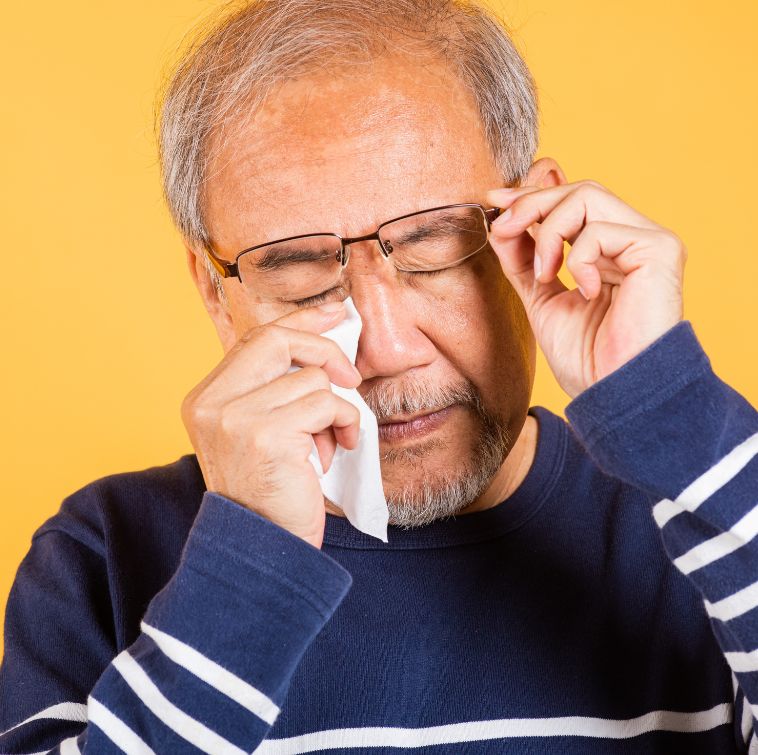Table of Contents

Introduction
What is happening to my eyes? Lately, they look red, they feel sort of itchy and are tearing. Do I have allergies, some type of infection, or could it be something else?
There is more than one answer to this question. Yes, it could be due to allergies, but there might be other reasons. Here we’ll explain the various conditions that could be the source of the problem and when you should visit your eye doctor for treatment, if it is necessary.
What Are the Typical Symptoms of Eye Allergies?
Usually, a reddish color to your eyes, a lot of tearing for no apparent reason, as well as the feeling of burning may very well indicate allergies. Allergies can also feel like you have grit or sand in your eyes, and occasionally, there is swelling. Both eyes are generally affected and can get even more uncomfortable if you are still exposed to the allergens that are causing this problem.
Allergies come on very quickly once you have been exposed to the specific problem allergen. You may start to sneeze and feel stuffiness in your nose and/or in your head. They aren’t contagious but can go on for quite some time and are quite annoying and uncomfortable unless you have the tools to deal with it.
What Can Cause Eye Allergies?
Mold spores, dust mites, pet dander, and pollen are all airborne allergens that are very likely to be the culprits. Smoke from cigarettes, pollution, various cosmetics, perfumes, and other fragrances can also trigger allergies. Mold spores may also be the reason for the problem.
If you wear contact lenses, you could very well have an allergic reaction to the protein that is building up on your lenses. Some people might even be sensitive to the solution they use for cleaning their lenses. Finding out what exactly is causing your eye allergies is the first step in managing and preventing these uncomfortable symptoms.
What Are the Types of Eye Allergies?
1. Seasonal Allergic Conjunctivitis (SAC)
2. Perennial Allergic Conjunctivitis (PAC)
3. Vernal Keratoconjunctivitis (VKC)
4. Atopic Keratoconjunctivitis (AKC)
5. Contact Allergic Conjunctivitis
6. Giant Papillary Conjunctivitis (GPC)
What Are the Treatments for Eye Allergies?
As mentioned above, treatment starts with simply avoiding the airborne triggers, making sure your windows are shut tight during the seasons when flowering pollens are released into the air, as well as having a good air purifier at home. Practicing simple hygiene like washing your hands and face often, as well as using prescription eye drops or oral medications, can also help reduce and relieve some of the itchiness, redness, and tearing. Another treatment remedy is the use of artificial tears. They can help wash out those culprit allergens as well as keep your eyes nice and moist.
When your symptoms are more severe, stronger prescriptions can be quite effective, such as more potent antihistamines. We might also prescribe mast cell stabilizer eye drops or corticosteroid drops. These drops are usually prescribed for short periods of time. To control your allergies for the long term, we can give you allergy shots. Contact lens wearers may have to stop wearing them for a period or they may just elect to use daily disposables in order to lessen their irritating effects. Your eye specialist will come up with the best plan for your treatment depending on your type of allergy and how severe it is.
Could It Be Dry Eye Instead of Allergies?
Of course, what feels like an allergy might simply be a dry eye condition. They each have similar symptoms, which is why they are generally confused. But dry eyes are caused by poor tear production, or tears that evaporate way too quickly. This is a problem that might come from continuous screen watching, changes in hormone production, medications, or aging.
Dry eyes can get more uncomfortable when the air is less moist or during windy weather. Artificial tears might be helpful, but if the discomfort continues, there are treatments for dry eye syndrome that can improve tear production and reduce inflammation.
Is It Possible to Have Both Allergies and Another Eye Condition?
The possibility exists that a person can experience eye allergies and still have another eye condition at the very same time. One of those eye conditions is allergic conjunctivitis, which leads to tearing, burning, and excessive redness symptoms. In this situation, the inflammation is caused by allergies while lower production of tears can be caused by dry eyes. Eyelid inflammation and infections can co-exist along with allergies, particularly if the patient often rubs their eyes. Bacteria can enter the eye this way, and the constant rubbing can lead to irritation of the eyes.
Because various conditions are involved, a successful diagnosis and treatment plan should be left to your experienced eye doctor’s team. Although treatment of one of your conditions may give some short-term relief, the actual condition that is causing it must first be diagnosed and treated in order for a good resolution.
How Can Golden Vision Help You with Eye Symptoms and Allergies?
Here at Golden Vision, the care of your eyes is designed to address your own particular symptoms. If you are experiencing dry eyes or allergies, our experienced team will implement specific diagnostic tools to address the cause of your symptoms and will recommend a treatment plan designed just for you. The plan could include prescription eye drops, managing your allergy, simple adjustments to your lifestyle, as well as frequent monitoring of your condition. We are here for you and want to help you find relief from your symptoms as well as the protection of your eyes’ good health for the long term. not alone on this journey.
Reach out to Golden Vision and book an appointment for personalized advice and support tailored to your unique needs.

